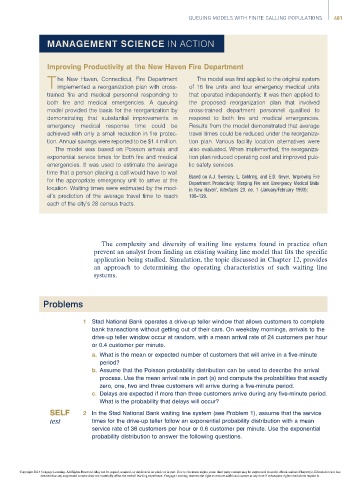Page 501 -
P. 501
QUEUING MODELS WITH FINITE CALLING POPULATIONS 481
MANAGEMENT SCIENCE IN ACTION
Improving Productivity at the New Haven Fire Department
he New Haven, Connecticut, Fire Department The model was first applied to the original system
T implemented a reorganization plan with cross- of 16 fire units and four emergency medical units
trained fire and medical personnel responding to that operated independently. It was then applied to
both fire and medical emergencies. A queuing the proposed reorganization plan that involved
model provided the basis for the reorganization by cross-trained department personnel qualified to
demonstrating that substantial improvements in respond to both fire and medical emergencies.
emergency medical response time could be Results from the model demonstrated that average
achieved with only a small reduction in fire protec- travel times could be reduced under the reorganiza-
tion. Annual savings were reported to be $1.4 million. tion plan. Various facility location alternatives were
The model was based on Poisson arrivals and also evaluated. When implemented, the reorganiza-
exponential service times for both fire and medical tion plan reduced operating cost and improved pub-
emergencies. It was used to estimate the average lic safety services.
time that a person placing a call would have to wait
Based on A.J. Swersey, L. Goldring, and E.D. Geyer, ‘Improving Fire
for the appropriate emergency unit to arrive at the
Department Productivity: Merging Fire and Emergency Medical Units
location. Waiting times were estimated by the mod- in New Haven’, Interfaces 23, no. 1 (January/February 1993):
el’s prediction of the average travel time to reach 109–129.
each of the city’s 28 census tracts.
The complexity and diversity of waiting line systems found in practice often
prevent an analyst from finding an existing waiting line model that fits the specific
application being studied. Simulation, the topic discussed in Chapter 12, provides
an approach to determining the operating characteristics of such waiting line
systems.
Problems
1 Stad National Bank operates a drive-up teller window that allows customers to complete
bank transactions without getting out of their cars. On weekday mornings, arrivals to the
drive-up teller window occur at random, with a mean arrival rate of 24 customers per hour
or 0.4 customer per minute.
a. What is the mean or expected number of customers that will arrive in a five-minute
period?
b. Assume that the Poisson probability distribution can be used to describe the arrival
process. Use the mean arrival rate in part (a) and compute the probabilities that exactly
zero, one, two and three customers will arrive during a five-minute period.
c. Delays are expected if more than three customers arrive during any five-minute period.
What is the probability that delays will occur?
2 In the Stad National Bank waiting line system (see Problem 1), assume that the service
times for the drive-up teller follow an exponential probability distribution with a mean
service rate of 36 customers per hour or 0.6 customer per minute. Use the exponential
probability distribution to answer the following questions.
Copyright 2014 Cengage Learning. All Rights Reserved. May not be copied, scanned, or duplicated, in whole or in part. Due to electronic rights, some third party content may be suppressed from the eBook and/or eChapter(s). Editorial review has
deemed that any suppressed content does not materially affect the overall learning experience. Cengage Learning reserves the right to remove additional content at any time if subsequent rights restrictions require it.

